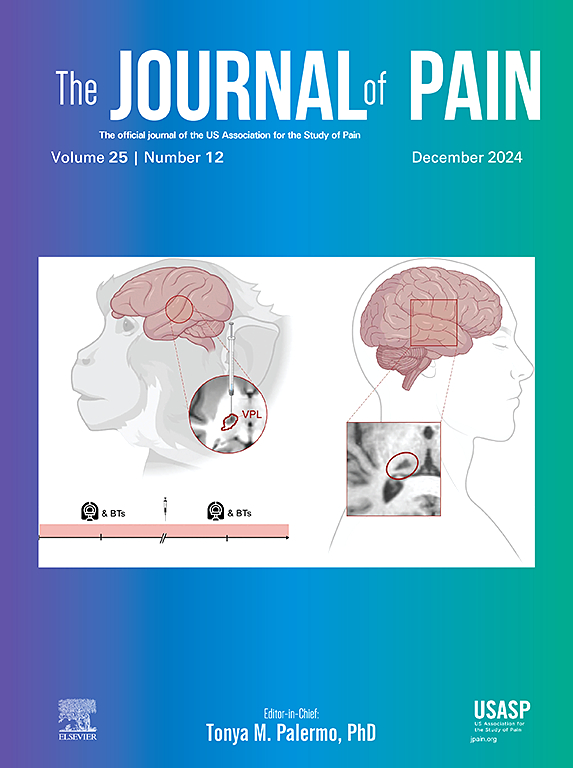使用抽象动画和人体图形图像评估镰状细胞病成人患者的疼痛后果。
IF 4
2区 医学
Q1 CLINICAL NEUROLOGY
引用次数: 0
摘要
Painimation是一种新颖的数字疼痛评估工具,患者可以使用抽象的动画和可绘画的身体图像来表达自己的疼痛质量、强度和位置。本研究通过测试镰状细胞病(SCD)成人患者的疼痛结果与有效疼痛结果之间的相关性,确定了疼痛动画和身体形象测量的构建有效性。分析使用了 359 名患有 SCD 和慢性疼痛的成人的多站点随机试验的基线数据。参与者填写了有关人口统计学、疼痛严重程度、频率和干扰、灾难化、阿片类药物使用、情绪和生活质量的问卷,以及疼痛估测应用程序。根据选定的疼痛动画对参与者进行分类,并根据绘制身体图像的比例将他们分成几组。在单变量分析中,"射击 "疼痛动画和较高的身体形象得分与较差的疼痛结果有关,但 "快乐 "情绪日除外。通过年龄、性别、种族、教育程度、残疾程度、发病部位、抑郁和焦虑对潜在的混杂因素进行了评估。在多变量模型中,只有抑郁评分有明显的协方差,说明身体形象评分和射击动画对除每日疼痛强度以外的所有结果都有影响。疼痛动画和身体形象测量结果均与经验证的疼痛结果、生活质量和心理健康测量结果相关。这表明动画和身体形象数据可以评估 SCD 疼痛的严重程度,其准确性可能高于 0-10 级评分。在探索性分析中,抑郁评分解释了疼痛模拟与其他疼痛结果之间的关联。未来的研究将探索Painimation是否能区分生物和社会心理疼痛成分。观点:本文通过研究 "疼痛动画 "和身体部位图像数据与日常电子日记和传统自我报告疼痛结果之间的关联,介绍了Painimation在镰状细胞病(SCD)中的初步构建有效性。本文章由计算机程序翻译,如有差异,请以英文原文为准。
The use of abstract animations and a graphical body image for assessing pain outcomes among adults with sickle cell disease
Painimation, a novel digital pain assessment tool, allows patients to communicate their pain quality, intensity, and location using abstract animations (painimations) and a paintable body image. This study determined the construct validity of painimations and body image measures by testing correlations with validated pain outcomes in adults with sickle cell disease (SCD). Analyses used baseline data from a multisite randomized trial of 359 adults with SCD and chronic pain. Participants completed questionnaires on demographics, pain severity, frequency and interference, catastrophizing, opioid use, mood and quality of life, plus the Painimation app. Participants were categorized by selected painimations, and were split into groups based on the proportion of painted body image. Potential confounding was evaluated by age, gender, race, education, disability, site, depression, and anxiety. The 'shooting' painimation was strongly associated with daily pain intensity, pain interference, frequency, and severity. 'Electrifying' was associated with daily pain and opioid misuse, while greater body area in pain correlated with worse outcomes across all pain measures. Both painimations and body image measures correlated with validated pain outcomes, quality of life and mental health measures. This demonstrates animations and body image data can assess SCD pain severity, potentially with more accuracy than a 0–10 scale. Future research will explore whether Painimation can differentiate biological and psychosocial pain components.
Perspective
This article presents the preliminary construct validity of Painimation in SCD by examining the associations of “painimations” and body area image data with daily e-diary and traditional self-report pain outcomes.
求助全文
通过发布文献求助,成功后即可免费获取论文全文。
去求助
来源期刊

Journal of Pain
医学-临床神经学
CiteScore
6.30
自引率
7.50%
发文量
441
审稿时长
42 days
期刊介绍:
The Journal of Pain publishes original articles related to all aspects of pain, including clinical and basic research, patient care, education, and health policy. Articles selected for publication in the Journal are most commonly reports of original clinical research or reports of original basic research. In addition, invited critical reviews, including meta analyses of drugs for pain management, invited commentaries on reviews, and exceptional case studies are published in the Journal. The mission of the Journal is to improve the care of patients in pain by providing a forum for clinical researchers, basic scientists, clinicians, and other health professionals to publish original research.
 求助内容:
求助内容: 应助结果提醒方式:
应助结果提醒方式:


